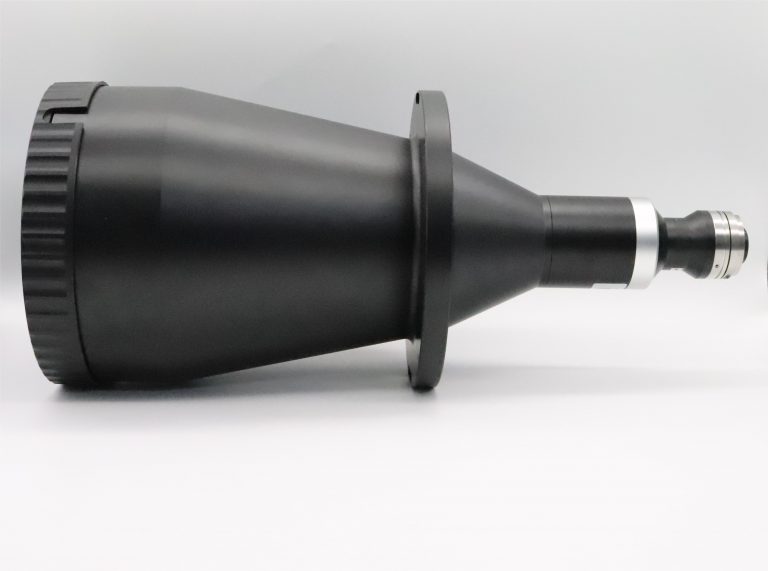Key Takeaways
- Telecentric lenses maintain a fixed working distance, unlike conventional lenses, ensuring consistent magnification and minimizing size distortion in the telecentric lens image.
- Object-Space Telecentric Lenses offer orthographic projections but may require a fixed working distance or focus ring for optimal performance.
- Image-Space Telecentric Lenses produce uniform-sized images regardless of object distance from the image sensor, crucial for applications sensitive to light angle incidence.
- Bi-Telecentric Lenses, featuring appropriate apertures at both ends, enable precise measurements and find wide applications in optics and metrology.
What Are Telecentric Lenses?
A telecentric lens is a type of optical lens that has an infinity for both or either its entrance or exit pupil. These lenses are important for Industry applications that specifically demand perfect precision with two-dimensional measurements. Telecentric lenses are effective in imaging objects that are subject to size distortion due to light incidence angles or image magnification.
What makes a lens telecentric is a lens’s ability to produce an orthographic image via a pupil (entrance or exit) that has been set to infinity or unlimited distance. Where normal lenses produce an image skewed by parallax or perspective error due to their defined focal length, telecentric lenses always give a definite perception of an object.

Types of Telecentric Lenses
Telecentricity is achieved by setting an appropriate aperture within the lens’s exit, entrance, or both. Incidentally, the type of telecentric lens is defined by the configuration of its appropriate aperture.
The following enumeration discusses the three types of telecentric lenses in more detail:
Object-Space Telecentric Lenses
The object-space telecentric lenses have their entrance pupil set to infinity by an appropriate aperture. This makes for them to produce an orthographic projection.
These types of lenses operate at a fixed working distance, meaning objects within the fixed working distance will appear sharp and in focus, while objects that are outside the working distance will appear out of focus and blurry.
Objects with these lenses may appear sharp or blurry depending on the object’s distance from them, but every object will be of the same size despite the difference in distance.
These types of lenses are the more expensive and larger variety of telecentric lenses. This is mainly because they have to be at least as big as the biggest object they have to capture. This often makes for more components to attain telecentricity.
Examples of these lenses are some microscopes. How do microscope lenses work? Microscope lenses are normally objective lenses. A microscope objective lens or its microscope objectives collect light from the sample to image a subject through a high-powered magnifying glass and a short focal length.
These lenses are used in microscopes instead of the usual microscope objective lenses. They have an adjustable working distance through a focus ring that adjusts the working distance for magnification. This comes at the cost of slightly losing telecentricity.
Image-Space Telecentric Lenses
The image-space telecentric lens has its exit pupil set to infinity by an appropriate aperture. This configuration produces the same-sized images regardless of the distance between the object and an image sensor.
Applications for these lenses include conditions that are sensitive to the angle of incidence, where the focus is vital not just from the center of the image but also in its periphery. An example of this would be image sensors that involve microlens arrays, like in digital cameras.
Bi-Telecentric Lenses
The bi-telecentric lens has both its entrance and exit pupils set to infinity by two appropriate apertures set on each end. This type of telecentric configuration allows for more accurate measurements than that of mono-telecentric lenses.
These lenses are naturally afocal due to the collimation of the object’s image formed by the first appropriate aperture by the second appropriate aperture.
Applications of these type of lenses include optical lithography, where light is used to make super thin patterns on materials like silicon wafers.
Pros and Cons of Telecentric Lenses
The use of telecentric lenses comes with its advantages and disadvantages.
The clearest advantage would be how they eliminate the parallax or perspective error. And their more obvious disadvantages pertain to their cost.
Here is an enumeration of the pros and cons of telecentric lenses:
Pros
- Elimination of parallax error – Conventional lenses provide an AFOV (angular field of view) that makes objects farther look smaller and objects closer to the lens larger. This makes for parallax or perspective error. Observed measurements done by these conventional lenses will be inaccurate. Telecentric lenses have a constant FOV (field of view) that makes magnification constant regardless of the distance to the object being measured.
- Superior image quality – Telecentric lenses provide image surfaces that are more undistorted and symmetrical.
Cons
- A little more costly – The price of these telecentric lenses is usually more expensive than conventional lenses. This may not necessarily be a con if your needs require that you use only telecentric lenses and nothing else.
- May sometimes be large and bulky – In object-space telecentric lenses that are required to be at least as large as the object they intend to image, size and bulk may be a problem if what you require to image is of significant magnitude.
In industries or fields of study that demand the capabilities of precise measurement through telecentricity, they are the only choice of lens. Their use is a non-compromisable decision. Therefore, the discussion of choosing conventional lenses over them is moot.
The Use of Telecentric Lenses
The applications of telecentric lenses are plenty across multiple disciplines of the industry, mainly in automated labor. They are a vital component of machine vision technology. This tech enables machines to “see” and process their work and accomplish their designated tasks.
They are mainly useful because of their reliability as machine vision guidance mechanisms in processes like machine vision inspection, machine vision inspection, and machine vision identification.
A few examples of these trades and industries that they help fulfill are:
- Automotive parts manufacturing
- Textiles production
- Solar power production
- Lithium-ion battery production
- Medical devices and equipment manufacturing
- 3C electronics manufacturing
- Optics
- Metrology
- Printing
- Pharmaceutical assembly and production
Any task that will benefit from telecentricity and the properties it brings to the table will benefit from using telecentric lenses.
Telecentric Lenses Are the Future
Telecentricity is achieved when one or both ends of a lens have an appropriate aperture. These lenses provide an image that sidesteps parallax error due to light angle incidence and image magnification. This means the image you acquire through them is the most accurate 2-dimensional representation of objects.
They are classified by where a fixed aperture is situated. Entrance-situated appropriate aperture lenses are called object-space telecentric lenses. These produce orthographic images of objects. These kinds may have a fixed working distance or may also come with a focus ring.
Exit-situated appropriate aperture lenses, or image-space telecentric lenses, will produce images of an object regardless of its distance from an image sensor.
If an appropriate aperture is affixed to both the entrance and exit, they are classified as bi-telecentric lenses. Wide uses of these range from optics to metrology.
They may be costly but will be worth all that money in applications that strictly require telecentricity – something that only they can deliver.
If your industry, study, or profession needs solutions to challenges that telecentricity and machine vision can solve, then it is time you incorporate their usage in your processes right away.
GREAT ARTICLE!
Share this article to gain insights from your connections!




